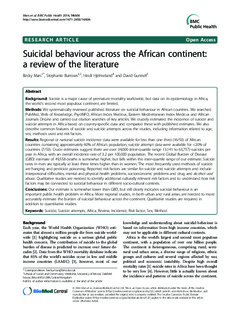| dc.description.abstract | Background: Suicide is a major cause of premature mortality worldwide, but data on its epidemiology in Africa,
the world’s second most populous continent, are limited.
Methods: We systematically reviewed published literature on suicidal behaviour in African countries. We searched
PubMed, Web of Knowledge, PsycINFO, African Index Medicus, Eastern Mediterranean Index Medicus and African
Journals OnLine and carried out citation searches of key articles. We crudely estimated the incidence of suicide and
suicide attempts in Africa based on country-specific data and compared these with published estimates. We also
describe common features of suicide and suicide attempts across the studies, including information related to age,
sex, methods used and risk factors.
Results: Regional or national suicide incidence data were available for less than one third (16/53) of African
countries containing approximately 60% of Africa’s population; suicide attempt data were available for <20% of
countries (7/53). Crude estimates suggest there are over 34,000 (inter-quartile range 13,141 to 63,757) suicides per
year in Africa, with an overall incidence rate of 3.2 per 100,000 population. The recent Global Burden of Disease
(GBD) estimate of 49,558 deaths is somewhat higher, but falls within the inter-quartile range of our estimate. Suicide
rates in men are typically at least three times higher than in women. The most frequently used methods of suicide
are hanging and pesticide poisoning. Reported risk factors are similar for suicide and suicide attempts and include
interpersonal difficulties, mental and physical health problems, socioeconomic problems and drug and alcohol use/
abuse. Qualitative studies are needed to identify additional culturally relevant risk factors and to understand how risk
factors may be connected to suicidal behaviour in different socio-cultural contexts.
Conclusions: Our estimate is somewhat lower than GBD, but still clearly indicates suicidal behaviour is an
important public health problem in Africa. More regional studies, in both urban and rural areas, are needed to more
accurately estimate the burden of suicidal behaviour across the continent. Qualitative studies are required in
addition to quantitative studies. | nb_NO |
| dc.description.localcode | © 2014 Mars et al.; licensee BioMed Central Ltd. This is an Open Access article distributed under the terms of the Creative Commons Attribution License (http://creativecommons.org/licenses/by/2.0), which permits unrestricted use, distribution, and reproduction in any medium, provided the original work is properly credited. The Creative Commons Public Domain Dedication waiver (http://creativecommons.org/publicdomain/zero/1.0/) applies to the data made available in this article, unless otherwise stated. | nb_NO |
